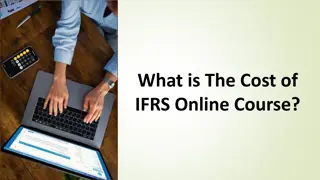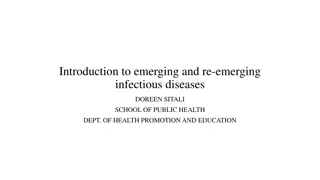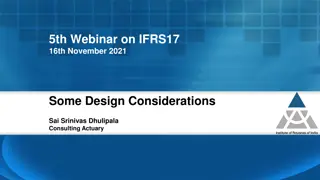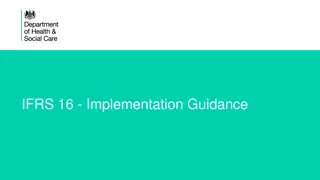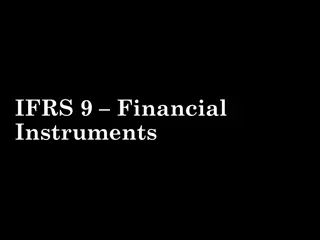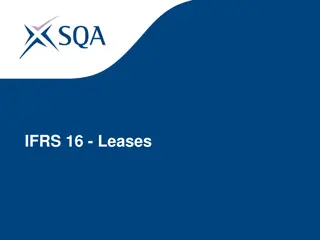IFRS 17 Disclosures Emerging Experience from Europe
Explore the European experience with IFRS 17 standards, impacts on financial reporting, & opportunities for efficiency. Key insights on new perspectives, data demands, and profit analysis.
Download Presentation

Please find below an Image/Link to download the presentation.
The content on the website is provided AS IS for your information and personal use only. It may not be sold, licensed, or shared on other websites without obtaining consent from the author.If you encounter any issues during the download, it is possible that the publisher has removed the file from their server.
You are allowed to download the files provided on this website for personal or commercial use, subject to the condition that they are used lawfully. All files are the property of their respective owners.
The content on the website is provided AS IS for your information and personal use only. It may not be sold, licensed, or shared on other websites without obtaining consent from the author.
E N D
Presentation Transcript
IFRS 17 Disclosures Emerging Experience from Europe March 2023 Alex Lee & Jeavon Sanghera EY UK
Experience from Europe and the UK Background Timeline Disclosures The European Experience
IFRS 17 a consistent framework Integration of time value of money 3 Assumptions used in the valuation reflect the characteristics of the insurance Underwriting revenue and expenses are recognized over time 2 4 contracts Up-to-date market - consistent information of obligations including value of options and Separate information about investment and underwriting performance Single accounting approach 5 1 guarantees Key impacts New perspective for analysts and users New data, systems, process and control demands Scarce resources under pressure KPIs or financial metrics likely to change Opportunities for streamlining and greater efficiency Clearer picture of profit drivers Page 3
A recap of the IFRS 17 timeline IFRS 17 - effective (1 January 2023) early application permitted in the UK/Europe IFRS 17 standard issued We are here 2017 2018 2019 2020 2021 2022 2023 2024 Implementation period Reporting First published IFRS 17 Interim report ( as at 31 March 2023) Finalization of amendments to IFRS 17 in June 2020 First IFRS 17 compliant annual reports published (as at 31/12/2023) Publication of Exposure Draft (ED) 26 June 2019 Start of IFRS 17 comparative period (1/1/2022) Page 4
Income statement - current vs. IFRS 17 Separation of underwriting and investment results IFRS 17 20xx Current 20xx Insurance revenue Gross earned premiums x X Insurance service expenses Net income or expenses from reinsurance contracts held Insurance service result (x) Earned premiums ceded to reinsurers (x) Net earned premiums x (x) Investment income x x Fair value gains and losses x Net investment income Finance income or expenses from insurance contracts issued Finance income or expenses from reinsurance contracts held Net investment result X Other revenue x (x) Gross benefits and claims paid (x) Claims ceded to reinsurers x X Gross change in contract liabilities (x) (x) Change in contract liabilities ceded to reinsurers x Other income x Net benefits and claims (x) Other expenses (x) Fees and commission expense (x) x Profit before taxation Management expenses (x) (x) Taxation Other expenses (x) x Net profit for the year Profit before taxation x (x) Other comprehensive income Taxation (x) x Total comprehensive income Net profit for the year x Other comprehensive income x Total comprehensive income x Page 5
Income statement - current vs IFRS 17 Expenses that are directly attributable to the portfolios Current 20xx IFRS 17 20xx Insurance revenue Gross earned premiums x X Insurance service expenses Net income or expenses from reinsurance contracts held Insurance service result (x) Earned premiums ceded to reinsurers (x) Net earned premiums x (x) Investment income x x Fair value gains and losses x Net investment income Finance income or expenses from insurance contracts issued Finance income or expenses from reinsurance contracts held Net investment result X Other revenue x (x) Gross benefits and claims paid (x) Claims ceded to reinsurers x X Gross change in contract liabilities (x) (x) Change in contract liabilities ceded to reinsurers x Other income x Net benefits and claims (x) Other expenses (x) Fees and commission expense (x) x Profit before taxation Management expenses (x) (x) Taxation Other expenses (x) x Net profit for the year Profit before taxation x (x) Other comprehensive income Taxation (x) x Total comprehensive income Net profit for the year x Other comprehensive income x Total comprehensive income x Page 6
Income statement - current vs IFRS 17 Effect of changes in discount rates and other financial risks Current 20xx IFRS 17 20xx Insurance revenue Gross earned premiums x X Insurance service expenses Net income or expenses from reinsurance contracts held Insurance service result (x) Earned premiums ceded to reinsurers (x) Net earned premiums x (x) Investment income x x Fair value gains and losses x Net investment income Finance income or expenses from insurance contracts issued Finance income or expenses from reinsurance contracts held Net investment result X Other revenue x (x) Gross benefits and claims paid (x) Claims ceded to reinsurers x X Gross change in contract liabilities (x) (x) Change in contract liabilities ceded to reinsurers x Other income x Net benefits and claims (x) Other expenses (x) Fees and commission expense (x) x Profit before taxation Management expenses (x) (x) Taxation Other expenses (x) x Net profit for the year Profit before taxation x (x) Other comprehensive income Taxation (x) x Total comprehensive income Net profit for the year x Other comprehensive income x Total comprehensive income x Page 7
Balance sheet - current vs. IFRS 17 Simplified presentation Current 20xx IFRS 17 20xx Assets: Assets: Investments x Investments # x Deferred acquisition cost x Reinsurance contract assets ** x x x Reinsurance assets Other receivables x Insurance receivables Total assets x x Other receivables Equity: x Total assets x Share capital x Equity: Retained earnings x x Share capital Other reserves x x Retained earnings Total equity x Other reserves Liabilities: x x Total equity Insurance contract liabilities ** ^ x Liabilities: Other payables x x Insurance contract liabilities Total liabilities x x Insurance payables Total equity and liabilities x Other payables IFRS 17 does not affect the measurement of financial assets as they are measured applying IFRS 9. ** Groups of insurance and reinsurance contracts in an asset position are presented separately from those in a liability position. No netting down of insurance or reinsurance contracts that are in asset position against the ones in liability position and no netting down between insurance and reinsurance contracts. ^ Acquisition cost cash flows, premiums receivable and unearned premiums are included in the measurement of insurance contracts. # x Total liabilities x Total equity and liabilities Page 8
New roll forward disclosure Premium Allocation Approach Though the accounting for Premium Allocation Approach ( PAA ) is not significantly different than the current accounting, it requires more disclosure requirements on risks, judgements used and presentation of financial statements. The key disclosure requirements are results of PAA eligibility testing and roll-forward disclosure. Page 9
Additional Disclosures List PAA: This covers: Eligibility Insurance acquisition cash flows for insurance contracts issued Liability for Remaining Coverage (LFRC), adjusted for financial risk and time value of money Liability for Incurred Claims, (LFIC) adjusted for time value of money Insurance finance income and expense Contractual Service Margin Risk Adjustment Level of Aggregation: Careful consideration needs to be given so that useful information is not obscured. Decisions need to be made on: Type of Contract Geographic Area Reportable Segment Risk Adjustment used; Technique used Confidence level Disclosure on development information: Choice to disclose previously unpublished information which is more than 5 years old Consideration of tail with regards to information disclosed Page 10 28 February 2024 Presentation title
Additional Disclosures List Choice to disaggregate insurance finance income and expense between profit or loss and other comprehensive income Disclosure on Significant Judgements when applying IFRS17 Other: Yield Curve utilised Concentration of risks Sensitivity analyses for each type of market risk to be disclosed Disclose the effect of the regulatory framework for capital framework e.g. MCR Disclose any changes in methods and processes for estimating inputs used to measure insurance contracts. Disclose and account for the changes in the risk adjustment for non-performance of a reinsurer in respect of reinsurance contracts held Treatment of insurance acquisition cashflows as an expense Page 11 28 February 2024 Presentation title
Disclosures Experience so far for GI insurers (1/2) Most insurers have provided information to investors on their IFRS17 impacts and approaches. The level of information does vary and final figures will mostly not be available until mid-year 2023 with interim financials on an IFRS17 basis. Key messages we have seen: Nearly all non-life insurers are using PAA for as much business as possible Most have tried to remind the market that ultimate profitability is unchanged Many non-life insurers have indicated they will use the option for impacts of changes in yields to go the Other Comprehensive Income (but typically this is being done to match how unrealised gains/losses on bonds are treated). The significant movements in yields in 2022 have made this a significant topic. The impact on the opening balance sheet equity position varies depending on insurer (some increases, some decreases) this was heavily influenced by the low yields at the 31/12/2021 opening balance sheet date Many of the larger European Groups have provided a lot of material at investor days to explain their views and approaches on IFRS17 Almost all non-life firms are using a bottom-up approach to determining their yield curves The impact on life business is more significant than non-life
Disclosures Experience so far for GI insurers (2/2) Practical issues Getting agreement with auditors on what to include in the year end 2022 IFRS4 accounts has been a significant discussion (there is a requirement to share information on the likely impact) Key metric released so far has been the impact on the opening balance sheet more than example income statements Roll-forward disclosure is proving the most difficult information to produce
KPI - Combined Ratio (1/2) Attributable expenses only, or incorporating non-attributable too? Expense figures may not appear on face of income statement but may be available within notes. Reserve release / deterioration figures should be able to be determined from notes. IFRS17 is best estimate reserving new for many insurers. Insurers/Industry need to decide which items are included in claims figures used for ratio IFRS 17 P&L include Risk Adjustment, Discounting and Loss Component. Should these be included? Current Year Net Incurred Claims Reserve Release / (Deterioration) Acquisition Costs Other Expenses Treatment of different kinds of commissions and RIPs may change meaning some removed entirely, and others treated differently (claims vs premium). Net Earned Premium Significant transaction / acquisition activity could skew revenue figures with incurred claims run off now flowing through as revenue. NEP no longer shown. Can be estimated if reinsurance revenue is split out in reinsurance result but this is optional. A net CoR may not be possible to derive for all IFRS reporters. Treatment of policy fees varies across markets. Default IFRS17 position is to exclude from Insurance Revenue.
KPIs Combined Ratio (2/2) IFRS17 changes the amounts that go into premium and claims. This impacts on what should be used as a combined ratio . The decision on what to use is a key decision this can often be influenced on what peers are showing (some peers will be reporting under US GAAP which is unchanged) Approaches have varied across the industry with no consensus yet: 1) Continue to produce something similar (using net revenue as a denominator) 2) Profit Margin of Gross premium (uses gross revenue as a denominator) 3) Internally continue to use same combined ratio as now (and only use IFRS17 figures as an external compliance exercise) 4) Remove discounting impact from the figures to show an undiscounted position
Sample Entity Comments Entity Combined Ratio Comments Profitability Admiral No longer reported net of all reinsurance No impact on ultimate profitability of business Written Allianz Expected to be similar or lower level due to Discounting Operating profit expected to be on similar level Ageas Deterioration by ~1.5pp due to movement to gross while improvement by ~2.5pp due to discounting of all new Claims Positive impact of discounting of new claims partially off-set by lower investment result Aviva Calculated net of Reinsurance Limited financial impact Generali Ratio methodology to change, incl. all expenses in the numerator. Slightly higher, owing to higher restated expense ratio and prior-year Development Operating result more sensitive to interest rates due to discounting Hiscox Slight deterioration expected due to increase in numerator (now gross basis) Reduced volatility as changes to investment return arising from interest rate movements are now partially offset by discount rate on net insurance liabilities Zurich Insurance revenue used as denominator in IFRS 17 resulting in slightly higher combined ratio all else equal Not expected to be materially different
Q&A Session Page 17


